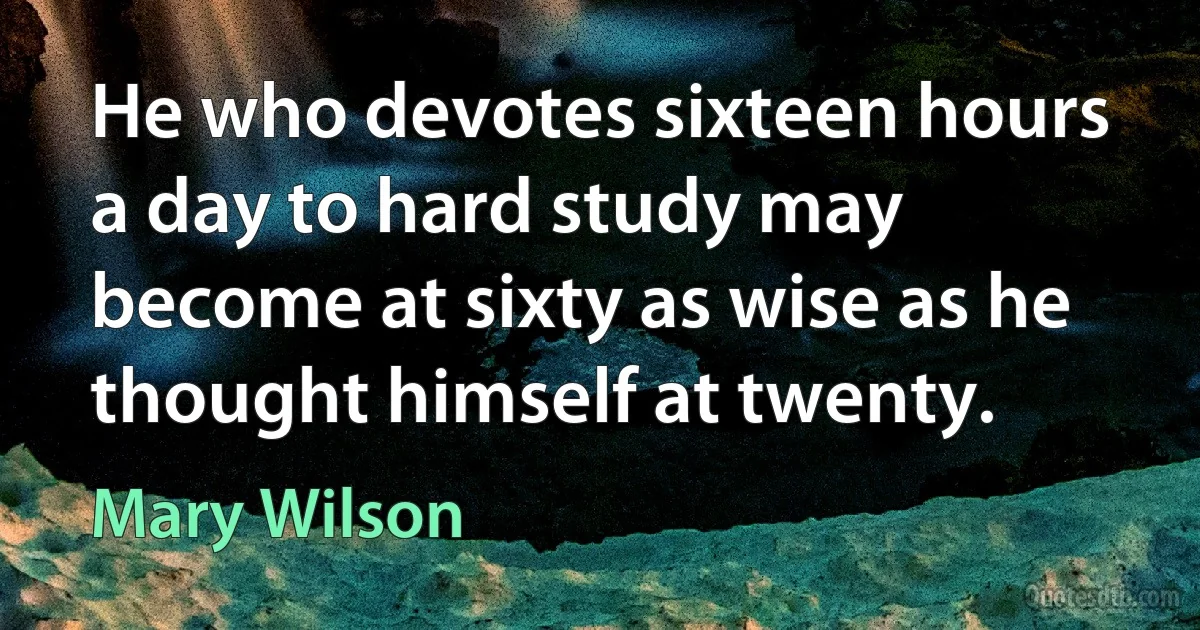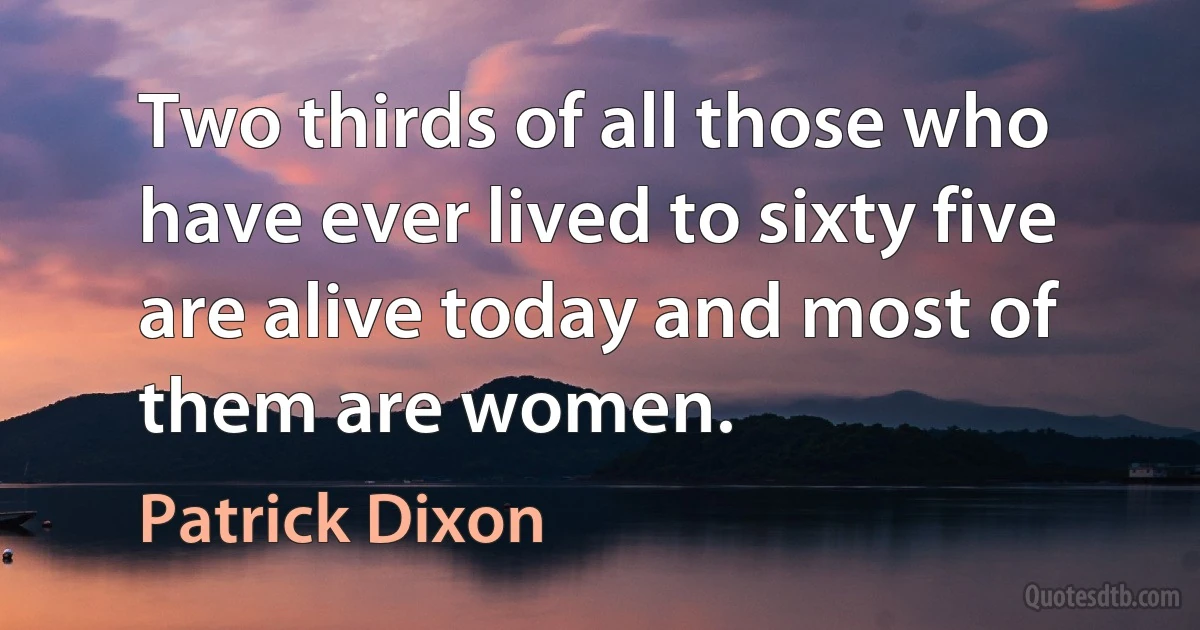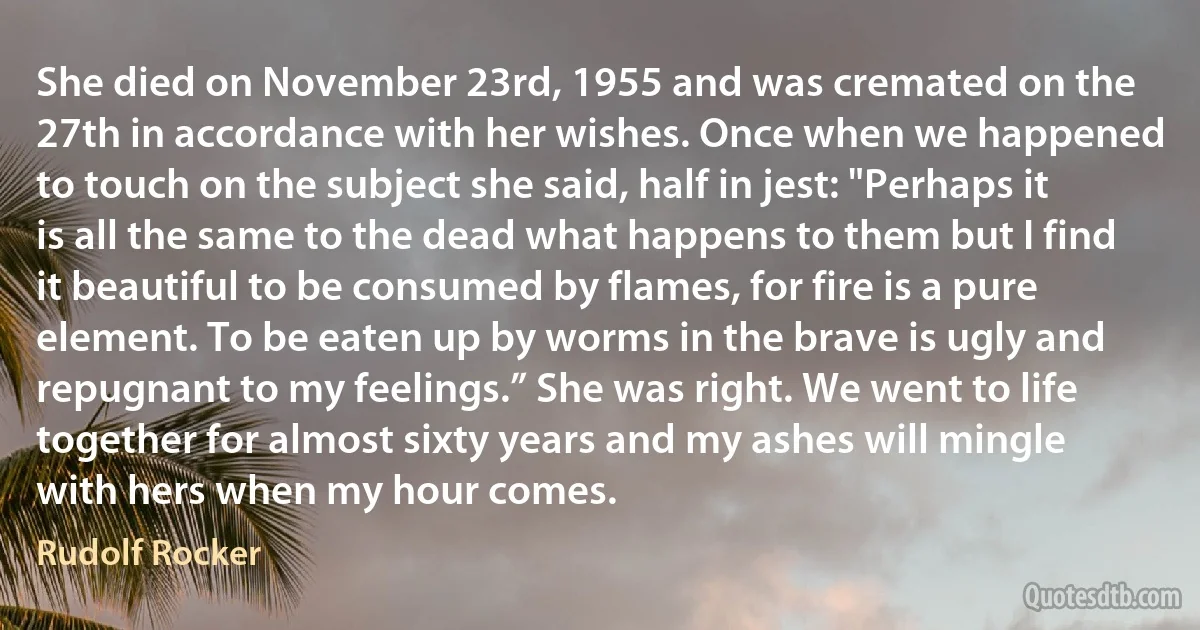Sixty Quotes - page 8
The average person is in the habit of saying, "The older I get" and he thereby calls the attention of his mind to the idea that he is getting older. In brief, he compels his mind to believe that he is getting older and older, and thereby directs the mind to produce more and more age. The true expression in this connection is, "The longer I live." This expression calls the mind's attention to the length of life, which will, in turn, tend to increase the power of that process in you that can prolong life. When people reach the age of sixty or seventy, they usually speak of "the rest of my days," thus implying the idea that there are only a few more days remaining. The mind is thereby directed to finish life in a short period of time, and accordingly, all the forces of the mind will proceed to work for the speedy termination of personal existence. The correct expression is "from now on," as, that leads thought into the future indefinitely without impressing the mind with any end whatever.

Christian D. Larson
"Sixty years ago Catholics played a prominent, prestigious, and irreplaceable part in American literary culture...They included established fiction writers--Flannery O'Connor, Katherine Anne Porter, Walker Percy, J. F. Powers, Ernest Hemingway, Paul Horgan, Jack Kerouac, Julien Green, Pietro di Donato, Hisaye Yamamoto, Edwin O'Connor, Henry Morton Robinson, and Caroline Gordon. (Sociologist Father Andrew Greeley had yet to try his formidable hand at fiction.)...also science fiction and detective writers such as Anthony Boucher, Donald Westlake, August Delerth, and Walter Miller, Jr."...in American poetry...Allen Tate, Robert Lowell, Robert Fitzgerald, Kenneth Rexroth, John Berryman, Isabella Gardner, Phyllis McGinley, Claude McKay, Dunstan Thompson, John Frederick Nims, Brother Antoninus (William Everson), Thomas Merton, Josephine Jacobsen, and the Berrigan brothers, Ted and Daniel.... There were even Catholic haiku poets, notably Raymond Roseliep and Nick Virgilio" (15-16).

Dana Gioia
In the turbulent years after 1933, anti-semitic slogans were current among the small shopkeepers of Vienna, as they had been sixty years before; they were directed primarily against the big department stores. In glaring contrast to the racial anti-semitism of the National-Socialists, however, the background to this movement was purely economic. No legal restrictions were placed on the Jews nor were any economic handicaps imposed,... There was never any discrimination in the schools, and in the academic profession, the business world and cultural life Jews continued to play their respected, even leading, role.

Kurt Schuschnigg
How can you become old in spirit? Only by carrying the past, isn't it? If you carry sixty years of burden with you, you're sixty years old. If you don't carry anything, you're like a newborn. The physical body may develop limitations, but the way you are has no limitations. It simply has no limitations. You are this many years old or that many years old simply because you carry that many years of garbage with you.

Jaggi Vasudev
Could I forget that the event [Mehmet Ali Ağca's assassination attempt] in Saint Peter's Square took place on the day and at the hour when the first appearance of the Mother of Christ to the poor little peasants has been remembered for over sixty years at Fatima in Portugal? For, in everything that happened to me on that very day, I felt that extraordinary motherly protection and care, which turned out to be stronger than the deadly bullet.

Pope John Paul II
Arnold's great project was a blank verse poem based loosely on the Lalitavistara Sutra. It ran for forty-one thousand words and was composed in eight volumes and published in 1879 as the Light of Asia: the Great Renunciation. The Light of Asia was an instant success and would capture the English speaking imagination. It would be reprinted numerous times in England and the United States. The best estimate I could find was sixty editions in England and another eighty in the US. The Light has also been translated into many languages, including Hindi. But, most importantly, it is generally credited as the first book to bring the life and teachings of Gautama Siddhartha broadly to the attention of the English speaking public.

Edwin Arnold
In 1942 I was the star in one of the filthiest dramas of all time. I was a seaman, and went to the Imperial Café on Scollay Square in Boston to drink; I drank sixty glasses of beer and retired to the toilet, where I wrapped myself around the toilet bowl and went to sleep. During the night at least a hundred seamen and assorted civilians came in and cast their sentient debouchements on me till I was unrecognizably caked. What difference does it make after all? - anonymity in the world of men is better than fame in heaven, for what's heaven? what's earth? All in the mind.

Jack Kerouac
Human beings are so constituted that we take for granted the fact that a direct awareness of our past selves is preserved... We take for granted the durability of the individual self. ...But ...the preservation of memories ...is as great an exercise in magic as the transfer of memories from the dead to the living. ...How the magic works ...is still a dark mystery. ...When once the technology exists to read and write memories from one mind to another, the age of mental exploration will begin in earnest. ...[W]e will look at nature directly through the eyes of the elephant, the eagle and the whale. We will... feel in our own minds the pride of the peacock and the wrath of the lion. That magic is no greater than the magic that enables me to see the rocking horse through the eyes of the child who rode it sixty years ago.

Freeman Dyson
I agree with you that a grave calamity overhangs the Liberal party in connection with the plan which I described to you in two peculiar monosyllabic epithets [mad and drunk]... Liberalism cannot put on the garb of Jingoism without suffering for it... [For sixty years my life has been] a constant effort to do all I could for economy & for peace; not the peace of this country only but of the world... it is not now economy but peace which supplies the key note of the situation... If the thing is to be done at all let it be done by those who think it right.

William Ewart Gladstone
Similarly calculating from the available figures for the three countries, the Hindu percentage had come down to 65.15% in 1991. To evaluate the trend of the Hindu percentage, we must take into account that the pre-Independence census always had a tentative category "tribal" or "animist", variously defined and therefore making odd quantitative jumps (but always between 2.26% and 3.26%), from 2.57% in 1881 to 2.26% in 1941. After Independence, this category was included in the Hindu category. So, putting everything on the post-Independence denominator, we include the "animists" in the Hindu percentage to get a total Hindu percentage of 77.35% for 1881, 71.72% for 1941, and 65.15% for 1991. Here again, we see a long-term acceleration of the observed trend: a decrease of 5.63% in the sixty years between 1881 and 1941, and a larger decrease of 6.57% in the shorter period of fifty years between 1941 and 1991.

Koenraad Elst
Sadly, Perkins was right that the door might not open to other women for a "long, long time." Twenty years passed before... Dwight Eisenhower, appointed... Oveta Culp Hobby... as secretary of health, education and welfare... Forty-two years passed before President Gerald Ford appointed Carla Hills as secretary of housing and urban development... Sixty years later President Bill Clinton appointed three women and eleven men to his cabinet.

Frances Perkins
I was a solitary, shy, priggish youth. I had no experience of the social pleasures of boyhood and did not miss them. But I liked mathematics, and mathematics was suspect because it has no ethical content. I came also to disagree with the theological opinions of my family, and as I grew up I became increasingly interested in philosophy, of which they profoundly disapproved. Every time the subject came up they repeated with unfailing regularity, 'What is mind? No matter. What is matter? Never mind.' After some fifty or sixty repetitions, this remark ceased to amuse me.

Bertrand Russell



